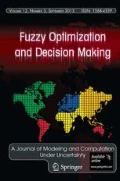Abstract
In this paper, an analysis of the convergence performance is conducted for a class of possibilistic clustering algorithms (PCAs) utilizing the Zangwill convergence theorem. It is shown that under certain conditions the iterative sequence generated by a PCA converges, at least along a subsequence, to either a local minimizer or a saddle point of the objective function of the algorithm. The convergence performance of more general PCAs is also discussed.
Similar content being viewed by others
References
Bezdek, J. C. (1980). A Convergence theorem for the fuzzy ISODATA clustering algorithms. IEEE Transactions on Pattern Analysis and Machine Intellegence, PAMI-2(1), 1–8.
Dave, R. N., & Krishnapuram, R. (1997). Robust clustering methods: a unified view. IEEE Transactions on Fuzzy Systems, 5(2), 270–293.
Dey, V., Pratihar, D. K., & Datta, G. L. (2011). Genetic algorithm-tuned entropy-based fuzzy C-means algorithm for obtaining distinct and compact clusters. Fuzzy Optimization and Decision Making, 10(2), 153–166.
Hathaway, R. J., Bezdek, J. C., & Tucker, W. T. (1987). An improved convergence theory for the fuzzy ISODATA clustering algorithms, the analysis of fuzzy information (Vol. 3, pp. 123–132). Boca Raton: CRC Press.
Höppner, F., & Klawonn, F. (2003). A contribution to convergence theory of fuzzy \(c\)-means and derivatives. IEEE Transactions on Fuzzy Systems, 11(5), 682–694.
Krishnapuram, R., & Keller, J. M. (1993). A possibilistic approach to clustering. IEEE Transactions on Fuzzy Systems, 1(2), 98–110.
Krishnapuram, R., & Keller, J. M. (1996). The possibilistic \(c\)-means algorithm: insights and recommendations. IEEE Transactions on Fuzzy Systems, 4(3), 385–393.
Krishnapuram, R., Frigui, H., & Nasraoui, O. (1995). Fuzzy and possibilistic shell clustering algorihm and their application to boundary detection and surface approximation. IEEE Transactions on Fuzzy Systems, 3, 29–60.
Oussalah, M., & Nefti, S. (2008). On the use of divergence distance in fuzzy clustering. Fuzzy Optimization and Decision Making, 7(2), 147–167.
Yang, M.-S., & Wu, K.-L. (2006). Unsupervised possibilistic clustering. Pattern Recognition, 39(1), 5–21.
Zangwill, W. (1969). Nolinear programming: a unified approach. Englewood Cliffs, NJ: Prentice-Hall.
Zhang, Y., & Chi, Z.-X. (2008). A fuzzy support vector classifier based on Bayesian optimization. Fuzzy Optimization and Decision Making, 7(1), 75–86.
Zhou, J., & Hung, C. C. (2007). A generalized approach to possibilistic clustering algorithms. International Journal of Uncertainty, Fuzziness and Knowledge-Based Systems, 15(2), 117–138.
Acknowledgments
This work was supported in part by the Shanghai Philosophy and Social Science Planning Project grant (2012BGL006), Australian Research Council Discovery Grants (DP1096218 and DP130102691) and Linkage Grants (LP100200774 and LP120100566).
Author information
Authors and Affiliations
Corresponding author
Rights and permissions
About this article
Cite this article
Zhou, J., Cao, L. & Yang, N. On the convergence of some possibilistic clustering algorithms. Fuzzy Optim Decis Making 12, 415–432 (2013). https://doi.org/10.1007/s10700-013-9159-8
Published:
Issue Date:
DOI: https://doi.org/10.1007/s10700-013-9159-8




